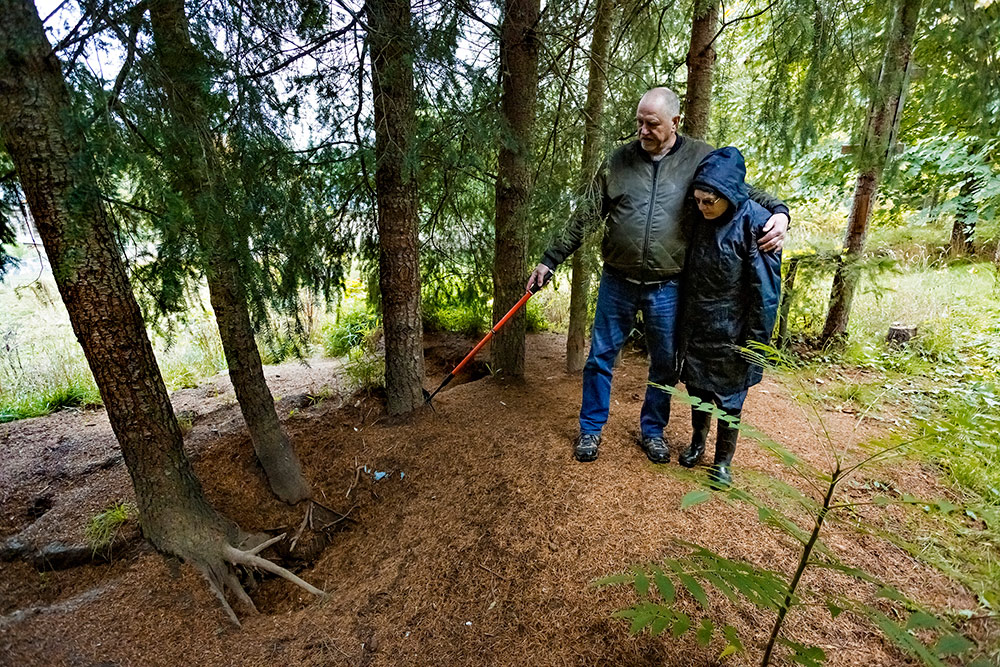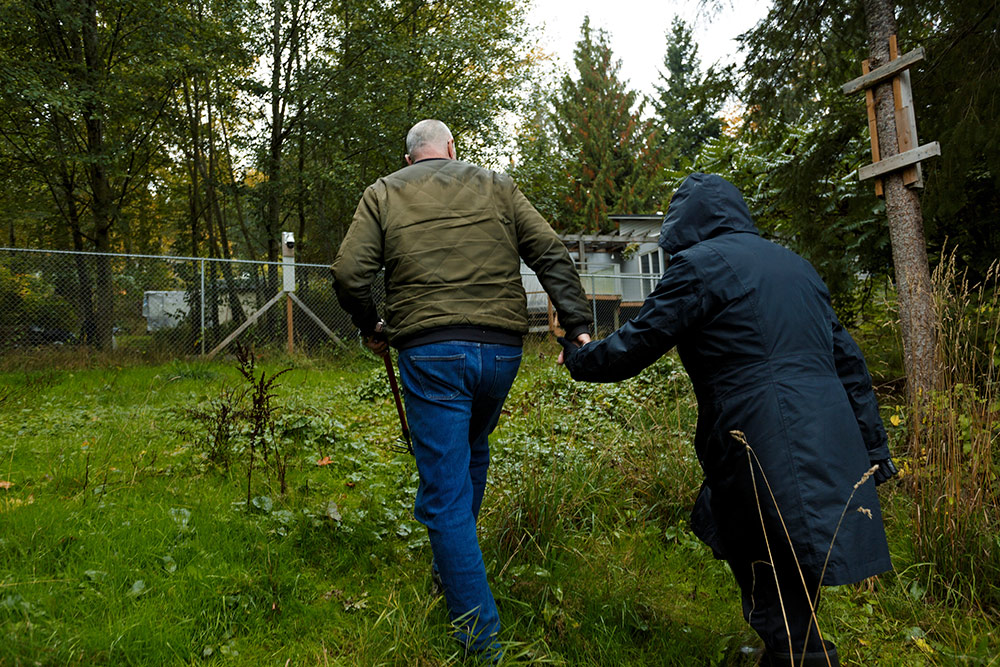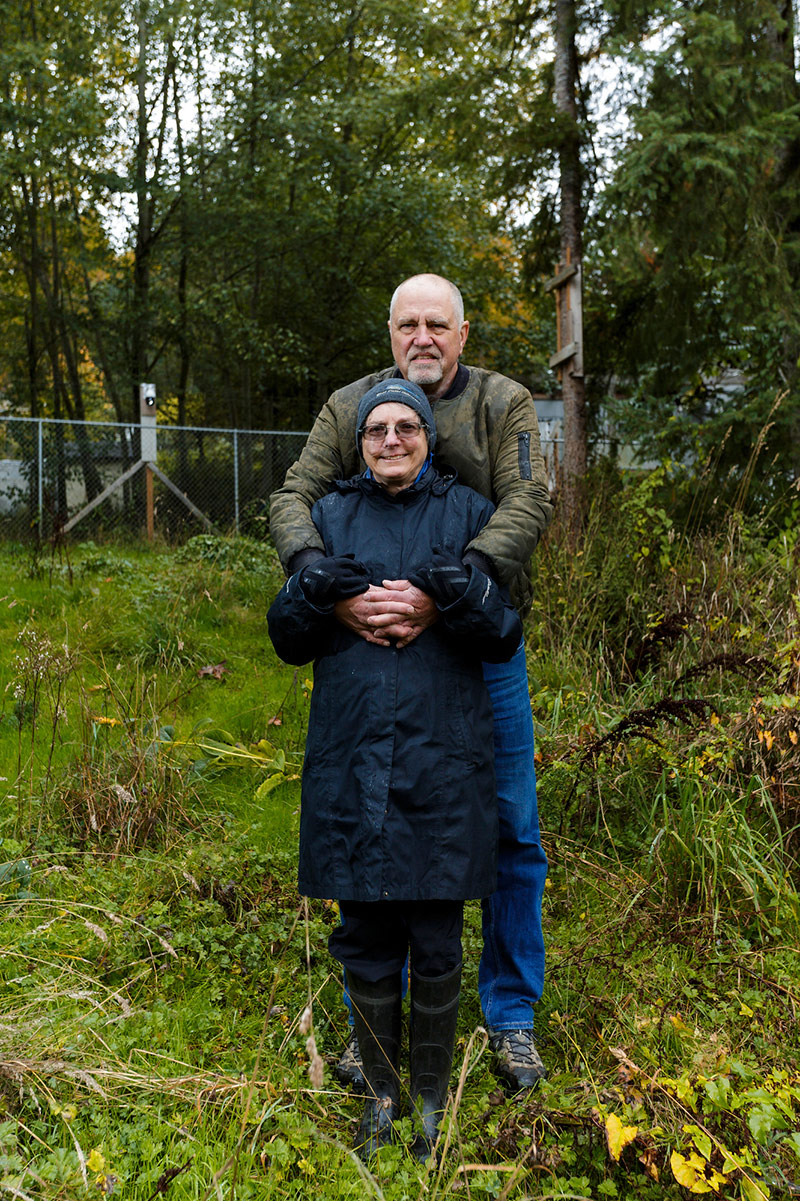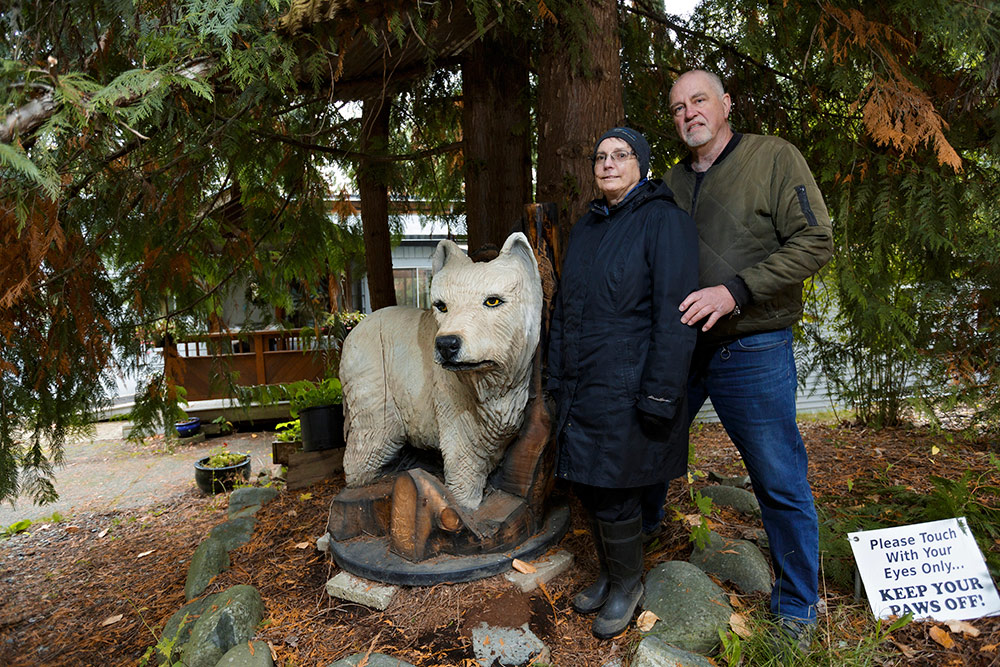Sally Allan lay on the ground bleeding, surrounded by three wolfdogs which had, in seconds, gone from familiar animals to predators. She thought she was going to die.
Seven-year-old wolfdog Mahikan had lived in the large enclosure on Sally and Gary Allan’s Nanaimo property since she was five weeks old. The Allans had four wolfdogs in total — hybrid canines that are part dog, part wolf.
Days earlier, Mahikan was wagging her tail at Sally and asking for tummy rubs. But on May 25, she led the almost fatal attack.
Mahikan and her two-year-old pups, Denali and Stqe:ye’, dragged Sally from the mouth of the den near the top of the wooded enclosure to the bottom of the pen. Sally was badly bitten on her head, arms, back and legs.
In all, she suffered 46 lacerations. Her thumb was almost severed, her left leg was badly injured, and the back of her head was torn open.
But after five weeks in hospital, plastic surgery and weeks of therapy and recovery at home, she is strong enough to walk through the now-empty enclosure and talk about what she and Gary believe precipitated the attack.
The Allans run the Tundra Speaks Society and SWELL Wolf Education Centre from their rural property. Gary, an advocate for stronger legislation to protect wild wolves, takes his 14-year-old wolfdog Tundra on school and community visits to educate people about wolves and the role they play in the ecosystem as a keystone species.
The other wolfdogs lived in an enclosure on the property. While visitors interacted with them only through the fence, the Allans regularly entered their pen. Gary went in about three times a day to feed them, give them treats and watch their behaviour, and Sally visited to pet Mahikan.
“Mahikan liked Sally giving her affection, and they had a very close bond,” Gary said, adding that the incident was very out of character.
In the wake of the attack that almost killed Sally and that ended the lives of three of their wolfdogs, the Allans researched possible reasons behind their sudden change in behaviour.
They’re speaking out now because they believe people need more information about how animals react when their habitat is changed or destroyed.

The Allans have kept wolfdogs due to their love of the animals, and for what Gary argues is the educational benefit — kids and adults meet Tundra and understand why it’s important to advocate for wildlife habitat preservation for wolves.
Keeping wolfdogs is legal in most parts of B.C. but discouraged by organizations like the SPCA. In 2018, an Albertan wolfdog sanctuary told the CBC it was at capacity in part because Game of Thrones had inspired people to adopt wolfdogs they couldn’t care for properly and needed to rehome.
Before the attack on Sally, Gary said the three wolfdogs had been showing signs of distress since a neighbour removed about two dozen alder trees close to the fence six days earlier.
The trees, which were leaning towards the fence, had needed to be removed — but Mahikan appeared stressed by the chainsaw noise and the tree removal and took her pups down to the furthest corner of the pen and howled.
“They want to make sure their environment and territory is safe and secure,” Gary said.
Sally was in the pen while the logging was taking place and, at one point, Mahikan jumped up at her, but not aggressively. “She was never anything but affectionate,” Sally said.
On the day of the attack, Sally noticed Mahikan lying listlessly in the pen, with her tail curled around her face, and went in to check on her.
“I patted her, and she didn’t move at all. I was trying to get my balance to get up and it just triggered her, and she lunged. I was there when [the logging] happened, and I think she decided it was my fault,” she said. “They were angry, and I was in the wrong place at the wrong time.
“I forgot they are not like pets,” she added. “If you fall or are on the ground, you become prey.”
Sally’s life was probably saved by a neighbour who heard screams and ran to the enclosure, calling the animals by name. As the wolfdogs moved towards the fence, Sally initially stayed still, not wanting to attract their attention.
“I thought it would help me if they thought I was dead,” Sally said. “Then I realized they had left me alone and I was not going to die. I was sitting up yelling ‘I am alive.’ I could breathe and talk. The rest was surface stuff and I figured they could fix that.”
As emergency services, including the RCMP, ambulance, fire department and conservation officers were arriving, Sally yelled to them to request they not shoot the animals.
Then she pulled out her phone and made her first call — to her Christian Science practitioner to ask the church family to pray for her.
“My faith is very deep. She told me I needed to forgive [the wolfdogs] and I needed to forgive myself. I said, ‘I have already done that, it wasn’t their fault,’” Sally said.
Her next call was to Gary, who was at a Nanaimo school talking to students about wolves and, as usual, emphasizing that wolfdogs should never be kept as pets. The Allans keep Tundra, who has a close bond with the couple and has undergone extensive training, to work as an ambassador for wolves. (They kept Mahikan, Denali and Stqe:ye’ outside, allowing them to retain many of their wild characteristics.)
As soon as Gary received the call, he hustled Tundra into the back of his truck and raced home. When he got there, he discovered Sally was still in the enclosure and emergency responders had not yet come up with a plan to get her out.
Gary grabbed a sharp garden hoe — the only weapon he could find as he ran to the pen — and tried to figure out his strategy.
“I knew they would come after me,” he said. “Sally was their prize. It was like me going in and trying to take away a dead raccoon.
“I had to get Sally up and walk about 80 feet to the gate. I had to walk with me supporting her and, at the same time, keep Mahikan away because she was going to come at me,” said Gary, who wonders why RCMP didn’t use rubber bullets or other methods to keep the animals at bay.
Const. Simon Gallimore, Nanaimo RCMP spokesman, told The Tyee that rubber bullets and Tasers are not designed to be used on animals.
“The use of such an option may well result in making a situation worse, as they may not incapacitate the animal or may aggravate the animal into greater aggression,” Gallimore said.
A first responder who was at the attack scene said it was difficult to act without fear of inflaming the situation. Sally was still in the pen and the situation was evolving rapidly.
As Gary entered the pen swinging the hoe, the two younger animals aggressively raised their tails. Mahikan then grabbed him by the pant leg and shredded his jeans but did not bite him.
“If she wanted, she would have got me,” he said later.
Staggering up the hill, supported by Gary, Sally yelled out her blood type and, finally, about three metres from the gate, Gary was able to hand her over to waiting RCMP and paramedics. After a quick assessment, Sally was airlifted to Victoria in a waiting helicopter and put in an induced coma.
Conservation officer Sgt. Stuart Bates, who was called to the scene to provide backup to the RCMP, says the animals were snarling and threatening to attack police officers when he arrived.
Officially, the three were considered dogs, not wildlife, so handling them didn’t fall within the mandate of the Conservation Officer Service. However, animal control had no ability to take them on and, making the situation more difficult, the animals hadn’t been vaccinated for rabies, Bates said.
The wolfdogs weren’t spayed, neutered or vaccinated because it wasn’t possible to leash them for veterinary treatment, Gary told The Tyee later. There are also questions about the efficacy of the rabies vaccine on wolves, he said.
Tests on the brains of the three animals later showed they were all healthy.
Gary realized within moments of reaching Sally that the animals would have to be put down and, as soon as Sally was out of the pen, he asked the conservation officers for help.
“I loved those animals and so did Sally, but there was no way we could keep them,” Gary said.
At Gary’s request, Bates shot the animals with tranquilizer darts and they were then killed with a rifle shot through the heart.
“The female pup was the last to be shot and, while she was still breathing, I bent down to pet her, which was the first time I was able to do that since she sniffed my fingers as a three-week-old pup. The conservation officers also gave me time with Mahikan and Denali before they shot them. I was able to say my goodbyes,” Gary said.

The contention that logging set the scene for the attack is familiar to Michele Smith of Port Hardy who, with her husband and dogs, was once trapped in their remote cabin by a pack of wolves that had apparently been displaced by logging.
The family usually accesses their cabin by boat, but it can also be reached by driving and hiking logging roads. Five years ago, Smith drove in with supplies for their first cabin stay of the season.
Smith, whose family works in the logging industry, was horrified at what she found as they approached the property. Both private land and adjacent Crown land had been cut, to the extent that the landscape was so changed she almost became lost while driving the familiar route.
“They had absolutely demolished the area,” she said. “It was catastrophic as far as logging went. I said to my husband, ‘Where are the animals supposed to go?’ I was actually heartbroken by it,” she said.
The next time they visited, the family travelled by boat. While they were unloading, one of the dogs was playing in the water. Suddenly, Smith noticed a wolf stalking him.
“I just ran to go and save my dog. I got down to the beach, and I was yelling and throwing boulders,” she said.
Eventually the wolf backed off, but Smith could hear the pack on the trail.
There were often wolves in the area, and Smith loved to watch them from a distance — but they’d previously always stayed away and never bothered dogs or humans.
Smith kept the dogs in the house after that. The next morning, while Smith was on her patio, a large male wolf approached the house. Despite yelling, pot-banging and an airhorn, the wolf started to climb the stairs and then remained by the house, with the pack in the background.
Smith realized the four wolves could circle the house and they were all in danger.
“That wolf was not afraid. He wanted us to go. He wasn’t snarling or showing his teeth, he just stood his ground,” said Smith, who called the Conservation Officer Service. “He said it sounded like territorial aggression and the wolves were trying to find a new location. We were in the way.”
Conservation phoned the RCMP, but no one could get to the area before high tide. So, while Smith remained on the phone to the RCMP and her husband followed with a rifle at the ready, she led one dog to the boat and then went back to get the second dog.
Once the family was safely out of the area, Smith and her husband tried to make sense of what had happened.
“The only thing that had changed in that timeframe was the logging,” said Smith, who hasn’t seen the pack since that day five years ago. “They were just trying to find a new habitat.
“We need more understanding of the connection,” said Smith, who wants to see more consideration of wildlife before logging plans or development projects are approved.
Scientists who study wolves are divided about whether habitat alterations can cause extreme changes in behaviour.
An Australian study documented changes in behaviour among various species after their environment is disturbed. A report by the International Wolf Center in Minnesota found many wild wolf attacks “occurred in areas where humans have greatly altered the environment.” And another study from Alberta concluded that the behaviour of wild wolves changes when roads and trails are built through their territory.
In the Allans’ case, the attack is complicated by the fact the animals were wolfdogs.
“The behaviours of hybrids are not well understood,” said Paul Paquet, a senior scientist with the Raincoast Conservation Foundation who’s studied wolves and coyotes for 35 years.
“The reality is that, if you deprive animals of life requisites, there are consequences,” Paquet said, adding that he’s heard anecdotal accounts of attacks occurring after animals’ environments were disturbed.
“But there are no definitive answers, and in this case, we will never know,” he said.
Michael W. Fox, a veterinarian, wolf researcher, former vice-president of Humane Society International and the author of more than 40 books on animal behaviour and bioethics, said the disruption of the noise and cutting of the trees could have upset the wolfdogs and put them on edge.
“It’s something we call redirected aggression,” Fox said. “If the animal feels threatened or challenged, it will sometimes redirect the fight/flight response. It’s just an adrenal surge. If they don’t run away, they have the possibility of focusing that energy to attack whatever they feel is now a threat.”
It’s a concern that the animals weren’t neutered, said Fox, who believes neutered animals wouldn’t have had such an extreme fight/flight response.
Gary said it was never his intention to breed Mahikan with Nahanni, the father of the pups who died in 2019 shortly after the pups were born. But Mahikan and Nahanni were resistant to being leashed and transported by van, making it impossible to get them spayed and neutered.
Peggy Callahan, executive director of the non-profit Wildlife Science Center in Minnesota, which is home to more than 60 wolves, believes the unpredictable nature of hybrid animals, rather than the threat to their environment, is far more likely to have precipitated the attack.
“We select for the absolute opposite things in dogs that wolves have been selected for for a million years,” she said, describing mixing the two species as “genetic blackjack.”
“We select for animals that are submissive and that show affiliation to us as puppies,” she added.
In a situation where a wolf is considering going after a human, she says, that human can tap into the flight part of the wolf’s fight-or-flight response because it’s hardwired. But the breeding selection leading to cuddly puppies means that in a wolfdog, that innate genetic response is muted and their response to any given trigger is less predictable.
The Wildlife Science Center has strict rules about dealing with hand-raised wolves, as the animals are always looking to take down a weaker member of the pack, Callahan said.
“We don’t sit, we don’t kneel around them, we are on our feet at all times, and we have a self-assessment before you go in and deal with them — did you take any cold meds today, are you feeling under the weather, do your muscles hurt? With any of those things, we don’t go in there. They are experts at reading body language,” Callahan said.
Canadian senior wolf biologists John and Mary Theberge “are not fans” of breeding wolves with dogs and don’t believe the behaviour of wolfdogs can be extrapolated to wolves that have evolved as part of wildland communities.
“There is little or no justification to breed wolves with dogs, and it reflects human domination over nature in a callous way,” John Theberge wrote in an email, adding that the behaviour of any captive animal can be unpredictable.
The arguments against wolfdogs are familiar to the Allans, but Gary points to the educational benefits. Initially, he’d had no plans to do wolf education, but after a couple of requests to take Tundra to schools, he saw how having her around made people interested in learning about wolves.
“Tundra was the perfect instructor,” he said.
Back at the Allans’ home, Tundra is flopped on an outsized dog mattress, watching the activity in the sitting room before sauntering over and asking for an ear scratch.
She’s lived with the Allans since she was three weeks old, which Gary believes allowed her to bond with humans similarly to how wild wolf pups, who leave the den when they are 15 days old, bond with other wolves in their pack.
The Allans acquired Mahikan and Nahanni from a breeder when they were five weeks old, Gary added, so they didn’t bond with the family to the same degree — although Mahikan usually showed affection towards them.
“The two pups acted like wolves in that they did not want any interaction with me,” Gary said. “In all the ‘wolves’ we raised, we never tried to change their innate behaviour. We let them be wolves, and we worked with what they gave us. If they wanted to associate with us, it was on their terms.”

The Allans’ house is dominated by photographs of wolves and wolfdogs, including pictures of Tundra meeting anthropologist and animal welfare activist Jane Goodall. The cameras that Gary and Sally watched for hours on end, making notes about the behaviour of the animals, are still pointed at the empty enclosure.
“We both miss them,” Gary said. “We would have our breakfast, and they would be in the corner [on camera] looking at us. I would say, ‘How many other people are having breakfast with three wolves.’”
No more pups will take the place of Mahikan, Denali and Stqe:ye’, as there is a chance the animals would outlive them, Gary said.
However, the Allans have no regrets about bringing in the wolfdogs or spending years of their lives educating people about wolves.
“We have learned so much from all these animals,” Gary said. “Their high level of intelligence, watching them grow as pups into adult wolves, how they dug their den, how Mahikan was such a great mother and raised her pups so lovingly and correctly. I have often said humans could learn from wolves as to how to raise their offspring.”
Their educational work has introduced them to so many interesting people, including Indigenous leaders, said Gary, adding that the prominence of wolves in First Nations history and creation stories is the reason the animals were given Indigenous names.
The experience has changed Sally’s life, even though she is healing well physically and emotionally.
“Things that used to make me annoyed or angry, I can laugh at them now,” she said. “Nothing could be as bad as what I went through, so the other things are not worth getting upset about.”
The empty pen is a constant reminder of the day their world upended, but Gary and Sally believe that their mission of educating people about wolves will continue, not only through Tundra and talks by Gary, but also through the deaths of their wolfdogs.
People must realize the potential harm that can come from habitat destruction, Gary said.
“We have got to get away from this human-centric thinking.” ![]()
Read more: Environment
















Tyee Commenting Guidelines
Comments that violate guidelines risk being deleted, and violations may result in a temporary or permanent user ban. Maintain the spirit of good conversation to stay in the discussion.
*Please note The Tyee is not a forum for spreading misinformation about COVID-19, denying its existence or minimizing its risk to public health.
Do:
Do not: